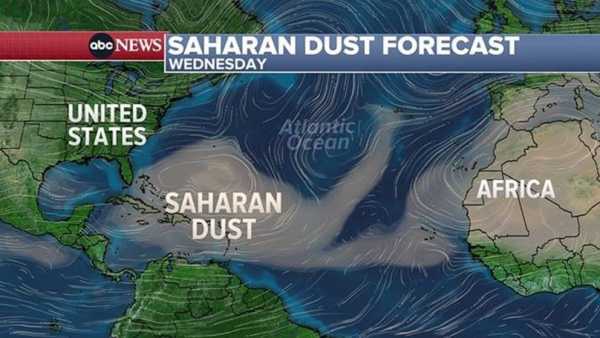A mass of Saharan dust has returned to South Florida, drifting thousands of miles across the Atlantic Ocean, reaching Miami and the Florida Keys Wednesday evening.
The dust is a cloud made up of particulate matter that originates in the Sahara Desert in northern Africa and can be blown over long distances, according to the Centers for Disease Control and Prevention.
Forecasts show the dust could travel up the Sunshine State and reach Tampa and Orlando over the weekend.
MORE: Climate change has many Americans reconsidering having children: POLL
Saharan dust transported to the United States is normal, especially from late June to mid-August, the CDC said.
Each year the atmosphere transfers several hundred million tons of the dust, made of minerals such as iron and phosphorous, across the Atlantic to the Caribbean, Central America and South America. The dust mainly affects Puerto Rico but can reach states, including Florida and Texas.

Saharan dust reached Miami on July 19 2023, traveling thousands of miles from Africa and across the Atlantic.ABC News
Although concentrations of the dust are not particularly heavy at this time, it will still have some effects as it reaches cities.
The sky will appear "milkier" or "hazy gray" to people and makes sunrises and sunsets more colorful.
Sahara dust will also limit thunderstorm development and enhance daytime heating by keeping the skies dry and trapping hot hair near the ground. This is because dust can absorb and reflect sunlight, according to the Earth Observatory at the NASA Goddard Space Flight Center.
However, Sahara dust can be harmful to health, according to the CDC.
MORE: Increasingly warming planet jeopardizes human health, major report warns
Air quality can become poor as particulate matter increases in the air. Additionally, the particles can be breathed in, entering the lungs and bloodstream and affecting those with asthma and upper respiratory complications. Others have described feeling symptoms often related to allergies.
Large particles from Sahara dust can also cause skin and eye irritation, the CDC said.
While anyone can be affected by Saharan dust, there are some groups at higher risk than others including babies and children, older adults, people with underlying conditions and those with heart or lung conditions, according to the federal health agency.
To protect one's health, the CDC recommends checking the local air quality index, reconsider spending time outdoors and, if you go outdoors, to perform easy activities like walking as opposed to running.
There are also benefits when it comes to how Saharan dust affects the ecosystem. For example, minerals in the dust, often rich in iron and phosphorous, can act like a fertilizer and help forests and other vegetation and soils gain nutrients.

Saharan dust is forecasted to return to southern Florida on July 23, 2023.ABC News
Additionally, the ocean's phytoplankton and other marine life benefit from the minerals in the dust. This is important because phytoplankton are the beginning of the food chain in the ocean and help sequester significant amounts of carbon.
However, there are cons, including that dust can accumulate and cover plants, cutting off their ability to undergo photosynthesis, harming or killing the vegetation.
What's more, the dust could be hiding plant-like bacteria, which — when deposited into the ocean — can lead to harmful algal blooms which can lead to a "red tide" of toxins in the oceans.
The dust can also aid in coral bleaching along with other factors such as very warm water and ocean acidification.
Sourse: abcnews.go.com






